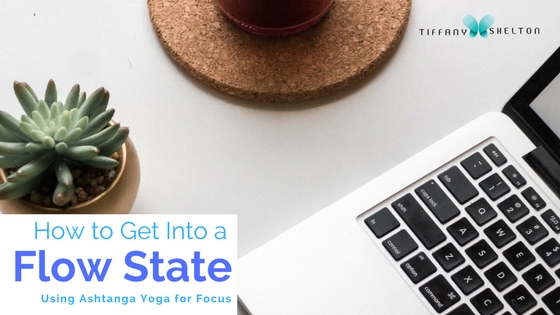How to Get into a Flow State
Using Yoga to Increase Concentration; Using Yoga to get into a Flow State
– Tiffany Shelton, M.A. is a conscious lifestyle blogger and training to become a neuropsychologist in Los Angeles, CA. Her passion to elevate consciousness incorporates brain science, psychology, and spiritual philosophies. Her writing goes beyond the message of self-care or wellness, but instead consciously adds to these movements by demanding awakening and insight. Learn more about Tiffany Shelton by clicking here.
Sign Up for the Conscious Lifestyle Newsletter for a Dose of Consciousness Straight to Your Inbox!
Click Here
“Yoga is the stilling of the fluctuations of the mind.”
-Pantanjali
Yummy Flow State
If you have ever experienced a flow state while working, you know that it can have extradonairy effects on your work. The work we produce during a flow state can be some of our most brilliant work that flows from our inner being with a sense of ease and creativity. A flow state also improves our ability to focus and concentrate as we work, offering us a divine sense of clarity and determination.
Flow state is the “work form” of meditation. Meditation is a spontaneous occurrence. You can’t sit down to meditate, you can only set the scene. Flow state works in exactly the same way. We can only set the scene for a flow state, we cannot force it. In this article, I am showing you how to set the scene for flow state using the last four limbs of Ashtanga Yoga.
This blog will focus on bringing you proven and empirical approaches to creating a flow state as you work. Not only is this article based on wisdom that dates back almost 4,000 years ago (obviously standing the test of time), but I’ll also be sharing brain science (neuropsychology) that supports what I am prescribing in this article.
Ashtanga Yoga
The first knowings of Yoga originated 4,000 years ago in Pakistan. The first writings were around 200 B.C.E. in the sutras of Patanjali. Since then people have been using yoga to enhance their lives and connect to the divinity within.
Specifically, Ashtanga Yoga has many benefits. It’s 8 limb path delineates a step-wise process to help us get into a meditative state, united with all that is divine. It is great for those looking for a step by step pathway for meditation. Also, it is generally great for those looking to go within and find personal insights from meditation.
Beyond giving us an exact pathway to meditation, Ashtanga Yoga is embedded with teachings that help us improve our ability to pay attention, concentrate, and focus.
The physical postures, or asanas, in yoga serve to exhaust the mind to allow ease of meditation thereafter. But Ashtanga yoga offers so much more than just asanas. Particularly, the last four limbs that prescribe steps for meditation, can teach us so much about concentration and focus.
What is Ashtanga Yoga?
Ashtanga Yoga, is a form of yoga meditation that gives us specific tools to increase our attention skills. With it’s popularization in the West, many know yoga in the context of physical fitness. However yoga is so much more than that. Created as a tool to help cease the fluctuations of the mind, the ultimate goal of Ashtanga yoga is enlightenment through meditation. Ashtanga lays out a path to meditation through 8 Limbs/steps to divine meditation. The popularized postures, or asanas, within yoga only make up one of the eight limbs Ashtanga Yoga. These eight limbs detail the steps one must take in order to reach a meditative state:
- Yama (Abstention: compassion for all living things, commitment to truthfulness, non-stealing, sense of control, denying greed)
- Niyama (Observance: inner and outer purity/cleanliness, contentment/gratitude, self-study, and spirituality)
- Asanas (Body Postures)
- Pranayama (Breathwork)
- Pratyahara (Withdrawal of consciousness)
- Dhyrana (Concentration)
- Dhyana (Contemplation or Devotion or Meditation on the Divine)
- Samadhi (Being or No Mind or Union with the Divine)
Once you have done the work required for the first four limbs, the last four limbs of yoga describe the meditative possibilities you can achieve. These last 4 limbs can also help help us set the scene for a flow state. Essentially, these four limbs can be used in our hustle to get us into a meditative flow state, tapping into a powerful and organic ability to concentrate and pay attention.
Here is easy guide on how to use the last four limbs to improve your ability to pay attention and concentrate.
I have labeled each limb according to what aspect of attention that they tap into (Executive Control, Alerting, Orienting, Holistic Awareness)
How to Get Into A Flow State
Pratyahara (Withdrawal of the Consciousness)
Executive Control
Pratyahara, the 5th limb of Ashtanga Yoga Meditation, focuses on internally attending and ignoring physical sensations. Alternatively one can pay attention to a mantra, visualization, image, intention, sound, or practice letting go of thoughts/sensations. In the case of setting the scene for a flow state, this step involves becoming aware of internal distractions and physical sensations and cultivating an ability to tolerate and ignore them. This requires becoming aware of what may distract us and in turn using our executive control to tolerate/ignore them and instead focus on our work.
When we sit down to concentrate, this limb is a very important first step. Becoming aware of internal emotions, thoughts, and sensations helps us take control of any possible distractors by bringing them into our consciousness without identifying with them. Noticing them, but letting them go. When we are aware of these things, we have the power to not let them control us while also acknowledging their presence. In this step, your work is to become aware of your internal state without letting them control you.
For example, you may notice that you are dealing with some resistance to sitting down and doing the work you are about to focus on. Acknowledge such feelings of apprehension, but take executive control to persevere regardless. With this is mind you can motivate yourself with self-talk such as “Time to work my beloved. The undisciplined are slaves to moods, appetites, and passions! I am a conqueror and slave to nothing.” Reciting a phrase this is helpful to put distractions aside, and set an intention to focus on work instead.
Dhyrana (Concentration)
Alerting and Orienting
Dhyrana, the 6th limb of Ashtanga Yoga Meditation, calls for one to move from attention to concentration, directing attention/thoughts to one object using intention and awareness to hold the mind still.
Once we have taken control of our consciousness, ignoring distracting thoughts, emotions and sensations, it is time to orientate ourselves to the object of concentration. When we are working, this is whatever we we are trying to concentrate on. It requires us to become keenly alert, and requires our reticular activating system in our brain. Then, we must call on our parietal lobe to to shift our focus visually, auditorily, and mentally to our work.
In this step we put what we want to focus on at the center of our attention. For example, in the context of work that means turning away from our phones, and distracting websites and orienting ourselves fully on our work.
Tips to help with this stage
- Try listening to alpha wave music as you work, which is said to help with concentration
- Eliminate technology distractions
- Try the Pomodora techinique of working which prescribes 50 minutes of complete concentration with 10 minute breaks for each hour of work
- Work in a clean work environment
- Have a notepad nearby for distracting thoughts or ideas
- Make sure you are getting enough sleep!
Dhyana (Contemplation or Devotion or Meditation on the Divine)
Holistic Awareness
Dhyana, the 7th limb, goes from concentration to contemplation. No longer holding the mind still but allowing the awareness of one’s existence to flow while still holding on to the awareness of the meditation object. This allows one to step back as an observer of the two.
Research on attention has shown that the right parietal lobe in our brain is more heavily involved in orienting than the left side. (Raz, 2004). The right side of our brain is the visual, creative side that sees the world more holistically, while the left side is more analytical, language oriented, and divisive. This research aligns directly with the holistic awareness prescribed in the 7th limb. As we set the scene for a flow state while we work, we can not limit our concentration to only our object of meditation (in this case work).
A flow state requires us to then expand our awareness to include awareness of ourselves as we continue to hold our object of meditation, which in this case is whatever we are working on.
Specifically, we can do this as we work by:
- Staying aware of ourselves as we work.
- Noticing our breath.
- Monitoring internal distractions,
- And visualizing ourselves as we work.
Essentially, expand your awareness as you work to have consciousness of yourself as you work. This holistic form of concentration, allows for a freedom that allows your concentration to continue to flow. When we only have awareness of the object of our concentration, that stifles our creative abilities and limits our ability to stay oriented towards our work. So in this step while still hold onto focusing on your actual work, you allow space to also perceive yourself within this concentration.
Samahadi (Being or No Mind or Union with the Divine)
Flow State
In the final stage of Ashtanga Yoga Meditation, Samahadi, one transcends ego and merges with the object of meditation. This is not an act but a state of pure being, releasing attention, concentration, and contemplation.
While working, this is the flow state! This is the energetic flow that happens when we merge with our work. In this state, creative juices flow organically and easily. Effort is minimal, and joy arises. We enter into this state after contemplation and expansion of awareness. It happens spontaneously when we set the scene using the prior limbs in this practice.
You’ll know it when you feel it. There is a divine connection to your efforts without identification with the work itself. It’s that feeling when you can’t step away from what your working, and moment after moment you find yourself overcome with divine inspiration that you channel into focused action. It is an openness to let yourself be a vessel for the most High as you fulfill your purpose.
It is simply a divine consciousness fueled by a meditative flow.
Please let me know how these tips work for you in the comments below and I want to hear your tips for concentration and attention as well.
References:
Book: Living Your Yoga: Finding Spiritual in Everyday Life by Judith Lasater, PhD
Book: Meditation the Complete Guide by Patricia Monaghan and Eleanor Viereck
Book: Yoga Sutras of Patanjali by Swami Vivekananda
– Tiffany Shelton, M.A. is a conscious lifestyle blogger and training to become a neuropsychologist in Los Angeles, CA. Her passion to elevate consciousness incorporates brain science, psychology, and spiritual philosophies. Her writing goes beyond the message of self-care or wellness, but instead consciously adds to these movements by demanding awakening and insight. Learn more about Tiffany Shelton by clicking here.
Sign Up for the Conscious Lifestyle Newsletter for a Dose of Consciousness Straight to Your Inbox!
Click Here
Follow me on Instagram: https://www.instagram.com/_tiffanyshelton/
Follow me on Twitter: https://twitter.com/_tiffanyshelton
Watch my conscious life hacks on YouTube: https://www.youtube.com/channel/UC3o0-fFDM-P1fU1d_Vr0cXA
Visit my store Conscious Life Shop: https://www.consciouslifeshop.com/






